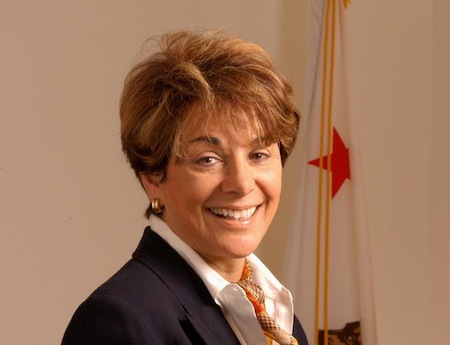GAO: Consumers Concerned About Wireline Usage-Based Pricing

Based on what it says are preliminary observations, the Government Accountability Office (GAO) has found that focus groups were generally OK with wireless usage based pricing (UBP), while expressing "strong negative reactions" to wireline UBP.
And while wireline UPB may not affect many consumers now, that could change. Of the wireline ISP's with data allowance tiers interviewed for the report, most said that less than 10%, and usually more like 1%-2% exceed their allowance. But those that appear to be using the net to replace traditional subscription TV consume on average 212GB per month, close to many current allowances.
That is according to the preliminary findings of a GAO report — the final report won't be ready until November.
GAO says that wireline ISPs told it that, at least for now, UBP is not about managing congestion.
The report was requested by Rep. Anna Eshoo (pictured) (D-Calif.) who represents Silicon Valley. An aide close to Eshoo said releasing the preliminary findings now was so they could be included in the formal comment period for the FCC's proposed new Open Internet rules — that comment period ends in September.
Seven of the 13 wireline providers surveyed use some form of UBP. Of those, three charge overage fees for exceeding allowances, two do not, while one offers a voluntary low-data plan for a discount and the other is testing various UBP approaches. All four of the top four wireless carriers use UBP.
The wireline concerns included having to worry about data usage at home when they were used to unlimited access, tracking usage in multi-person, multi-device-per-person, households with and that ISPs would use UPB as a way of increasing the amount they charged.
Broadcasting & Cable Newsletter
The smarter way to stay on top of broadcasting and cable industry. Sign up below
In the cases of both wireless and wireline broadband, GAO said focus group participants' angst was driven in part by confusion over the caps. for wireless, those were focused on "Uncertainty over plan details, such as their data allowance," and "Uncertainty whether their plans were subject to throttling." For wireline, that included that UBP might require them to curtail online activities like shopping, or that social media applications left running in the background could use up large amounts of data.
Confusion over their limits and plans could also mean some subs are missing out on the cost savings in UBP by not knowing where they stand in terms of data use. One of the top-four wireless ISPs interviewed said that only a small percentage of its customers are on 500MB or smaller plans, while the median wireless broadband use is 102MB per month. A wireline ISP said that while they offer a 5GB data plan, only a small percentage of customers have signed up for that option, even though almost 20% of the customers use less than that per month.
That, says GAO, suggests more consumers could benefit from the lower cost, low-data plans, though it also adds that "More consumers could exceed current allowances as data usage continues to grow."
While some members in all eight groups reacted negatively to wireline UBP, it is noteworthy that in only two of those eight did participants say they had any experience with wireline UBP.
And participants had some good things to say about UBP, including liking the idea of paying less for using less, and thinking it was more fair to pay only for data uses, as you would a utility like electricity — there appeared to be no follow-up to that question about regulating broadband as a utility.
Of those who did express strong negative reactions to UBP, some were concerned about a disproportionate impact on students, telecommuters and low-income users. Some participants said that they would look at switching providers if faced with wireline UBP, but cited a lack of options.
ISPs talked about the upsides of usage-based pricing. Those included that lower-cost bands could encourage some without Internet to subscribe, that the additional revenues that UPB can generate will help them increase capacity, and that, in the case of wireless, it can help manage congestion — wireline ISPs said that was not a problem for them.
GAO said some "experts" it consulted found UBP drawbacks included that it may be unnecessary since marginal costs for data delivery and heavy users impose "limited" additional costs; that increasing price may limit their use of the 'net; and that it could limit innovation, particularly in the form of data-heavy applications. That is a point Silicon Valley has made in D.C.
“As the FCC continues to seek comment on its proposed net neutrality rules, it’s more important than ever that policymakers understand data caps and how they might enable broadband providers to circumvent open Internet rules that ensure consumers have uninhibited access to the Internet," said Eshoo in releasing the findings at a presentation on the Hill Tuesday.
The GAO report is based on interviews with the top 13 wireline and top four wireless ISPs (covering a total of 97% of the country); Wireless market share data from the FCC; wireline market share data from Leichtman Research Group; interviews witresearchers, public interest groups, and industry associations; and eight focus groups (total of 77 people) made up of wired and wireless broadband users, of a mix of ages, races, genders, education and income, in Baltimore, Des Moines, Las Vegas and New York.
Contributing editor John Eggerton has been an editor and/or writer on media regulation, legislation and policy for over four decades, including covering the FCC, FTC, Congress, the major media trade associations, and the federal courts. In addition to Multichannel News and Broadcasting + Cable, his work has appeared in Radio World, TV Technology, TV Fax, This Week in Consumer Electronics, Variety and the Encyclopedia Britannica.










